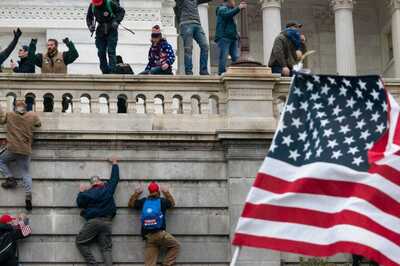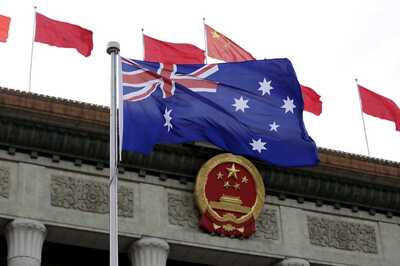
views
New Delhi: Narendra Modi is returning to power with a bang, silencing skeptics and stunning opponents, with the BJP-led National Democratic Alliance (NDA) likely to win 336 seats in Lok Sabha elections 2019, according to a comprehensive News18-Ipsos exit poll.
The Modi landslide will see the BJP alone crossing the half-way mark, hinting at a new dawn in Indian politics where nationalism trumps caste divide and localised issues. It would also be the first time that a party other than the Congress is being returned to power with a majority of its own.
UPA, the principal opposition alliance led by the Congress, will find its ambitions capped at a dismal 82.
With Prime Minister Modi leading from the front, the NDA is likely to sweep the states of Rajasthan, Madhya Pradesh, Gujarat and Jharkhand, and improve its tally in Karnataka and Maharashtra. In Uttar Pradesh, where it is locked in a bitter battle with the SP-BSP Mahagathbandhan, the BJP could end up losing a few seats but that would be offset by significant gains in Odisha and West Bengal, the survey predicts.
The NDA had contested this election highlighting the government’s achievements and Modi himself had sought votes for seamless continuity in his policies. The exit poll indicates voters from Kashmir to Kanyakumari bought into Modi’s India Dream.
The survey shows the BJP winning 276 seats — six seats less than 2014 —followed by the Congress, TMC and DMK.
The exit poll hints at a political picture that would stun every poll pundit. Not only has the BJP/NDA managed to hold on to the all-time best, they have scored in many Hindi hinterland states, they have also managed to break new ground in states like Bengal and Odisha besides registering a stellar performance in the North East.
The mandate, should the exit poll predictions come true, would strengthen the hands of the PM allowing him to shape his new government the way he chooses to without any support from outside. The bitterly fought elections had everyone hanging to the edge of their seats and the consensus among non-NDA parties was that even if Modi has an edge, he might have to enlist new political parties to attain simple majority and form a government. The rationale: NDA had hit a peak in 2014 and it could only go down from there.
Modi, it seems, has now turned that wisdom on its head.
The News18-Ipsos poll also foresees dark times ahead for the Congress party. The Congress would be able to only marginally improve its current tally of 44 — its lowest in history — to 46, potentially relegating the grand old party to the fringes of national politics. The Congress wins could largely be limited to Punjab and Kerala (where its tally could actually go down despite Rahul Gandhi contesting from Wayanad), while its campaign in states like UP seem to have only helped NDA gain by splitting Opposition votes.
A stronger Modi would be able to follow through on his message of continuity, undertaking crucial reforms that were left incomplete during NDA 2. Goods and Services Tax (GST), which will complete two years of rollout on July 1, will likely see a stronger push towards simplification.
The BJP in its manifesto has talked about simplification of GST, given that the small and medium enterprises have had to put up with multiple rate changes, teething return-filing problems and cumbersome procedures. Banking reforms — a much-pending step highlighted time and again by the controversies surrounding fugitive economic offenders like Vijay Mallya and Nirav Modi — could finally see some movement while his pet projects like easy loans to the small and medium sector would gather speed.
The PM had highlighted his strong stand vis-à-vis Pakistan throughout this campaign, and one can expect more stern steps in containing cross-border terror.
The News18-Ipsos exit poll was conducted through all the seven phases of Lok Sabha elections by Ipsos, world’s top international pollster that boasts a solid track record of predicting the electoral outcomes of several elections around the world with accuracy.
The News18-Ipsos survey, one of the most comprehensive exit polls undertaken in Indian electoral history, was conducted among 1,21,542 voters from 199 parliamentary constituencies. Within the parliamentary constituencies, 796 assembly constituencies were selected, and then 4,776 individual polling station areas were selected for conducting interviews. In each polling station, around 25 voters were randomly selected depending on the terrain and voter turnouts in that particular polling station.
The survey was conducted on the election day in all seven phases of the polling. The interviewing process started when the polls opened and continued throughout the day until polls closed to ensure better representation of the voters, coming in at different time cluster for voting. Each polling booth was covered for one hour, by three interviewers. They then moved to next polling booth. All interviews were conducted using Computer-assisted personal interviewing (CAPI) devices.
To overcome prejudice/response bias, election symbol including party name of key parties contesting in respective constituency were shown in one screen. When asking voting related questions, a virtual polling booth scenario was created, wherein we hand over the data capturing device to respondent on which they were allowed to mark the party they had voted for.
The questionnaire was translated into vernacular language which is mainly spoken in the respondents’ state. Data was weighted to reflect the constituency profile on age, gender, caste, religion and voter turnout.


















Comments
0 comment